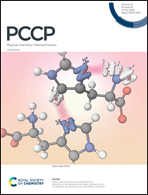A phosphonic acid anion and acid dimer dianion stabilized by proton transfer in OHN hydrogen bonds – models of structural motifs in blend polymer membranes
Abstract
The structure of intermolecular hydrogen-bonded complexes formed between tert-butylphosphonic acid and trimethylpyridine molecules has been experimentally studied as the simplest model system of the structural motifs in blend proton-conducting polymer membranes based on phosphonic acid residues. The stoichiometry of the formed complexes and proton positions in OHO and OHN hydrogen bonds were established by the H/D isotope effects and temperature dependences of the signals in 1H and 31P NMR spectra. Two structural motifs, namely, 1 : 2 and 2 : 2 acid-base complexes, were identified at the low temperature in a polar aprotic environment. In the 1 : 2 complex, one proton has passed through the hydrogen bond center creating a chain of two cooperatively coupled OHN bonds, while in the 2 : 2 complex both OHN bonds are zwitterionic and anti-cooperatively coupled to each other via a dianionic cyclic dimer of phosphonic acid in the middle. The dianionic cyclic dimer is metastable by itself, but under the used experimental conditions it is stabilized by complexation with two trimethylpyridinium cations. Additionally, quantum chemical calculations using the DFT method were carried out to support the experimental data.



 Please wait while we load your content...
Please wait while we load your content...